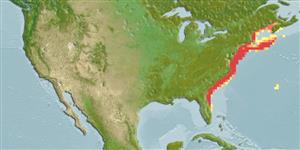>
Perciformes/Scorpaenoidei (Scorpionfishes) >
Triglidae (Searobins) > Prionotinae
Etymology: Prionotus: Greek, prion, -onos = saw + Greek, noton = back (Ref. 45335); evolans: In Cuvier & Valenciennes. Author from Eschmeyer (Ref. 56787).
More on author: Linnaeus.
Environment: milieu / climate zone / depth range / distribution range
पारिस्थितिकी
समुद्री; खारा प्रवाल-भित्ति संयुक्त; गहराई सीमा 9 - 180 m (Ref. 93252), usually 20 - 70 m (Ref. 27549). Temperate; 46°N - 26°N, 82°W - 63°W
Western Atlantic: Nova Scotia in Canada to northern Florida in the USA; rare north of Cape Cod in Massachusetts, USA.
Length at first maturity / आकार / वज़न / Age
Maturity: Lm 22.1 range ? - ? cm
Max length : 45.0 cm TL पुल्लिंग / अलिंग; (Ref. 7251); common length : 30.0 cm TL पुल्लिंग / अलिंग; (Ref. 3822); अधिकतम प्रकाशित वज़न: 1.6 kg (Ref. 4699); अधिकतम सूचित उम्र: 7 वर्षो (Ref. 55523)
Occurs mainly on sand bottom from inshore estuaries to about 180 m depth. Found occasionally over reefs. Feeds mainly on crustaceans and fishes. Used both for food and fish meal; other uses include for bait, pet food and fertilizer.
Robins, C.R. and G.C. Ray, 1986. A field guide to Atlantic coast fishes of North America. Houghton Mifflin Company, Boston, U.S.A. 354 p. (Ref. 7251)
IUCN Red List Status (Ref. 130435)
Threat to humans
Harmless
Human uses
मात्स्यिकी: लघु वाणिज्य; आखेट मत्स्य: हां; ठहराव / प्रलोभन: occasionally
अधिक जानकारी
संदर्भजलीयकृषिजलीयकृषि रूपरेखाखींचआनुवंशिकीElectrophoresesहैरेटिबिलटीबीमारीप्रक्रमणNutrientsMass conversion
सहयोगीयोतस्वीरेStamps, Coins Misc.ध्वनिसिगुयटिरारफ्तारतैरने के प्रकारगिल क्षेत्रOtolithsदिमागदृष्टि
साधन
Special reports
Download XML
इंटरनेट स्रोत
Estimates based on models
Preferred temperature (Ref.
123201): 8.4 - 24.6, mean 12.7 °C (based on 126 cells).
Phylogenetic diversity index (Ref.
82804): PD
50 = 0.5000 [Uniqueness, from 0.5 = low to 2.0 = high].
Bayesian length-weight: a=0.00776 (0.00475 - 0.01270), b=2.95 (2.81 - 3.09), in cm total length, based on LWR estimates for this species & Genus-body shape (Ref.
93245).
Trophic level (Ref.
69278): 4.3 ±0.0 se; based on diet studies.
Generation time: 3.8 ( na - na) years. Estimated as median ln(3)/K based on 1
growth studies.
लौटाव (Ref.
120179): माध्यम, न्यूनतम जनसंख्या दुगनी होने का समय 1.4 - 4.4 वर्ष। (K=0.29).
Fishing Vulnerability (Ref.
59153): Moderate vulnerability (36 of 100).
Nutrients (Ref.
124155): Calcium = 14.1 [5.7, 28.7] mg/100g; Iron = 0.218 [0.107, 0.440] mg/100g; Protein = 17.9 [15.6, 21.0] %; Omega3 = 0.667 [0.277, 1.956] g/100g; Selenium = 8.88 [3.82, 21.53] μg/100g; VitaminA = 82.4 [24.8, 298.9] μg/100g; Zinc = 0.506 [0.331, 0.763] mg/100g (wet weight);
